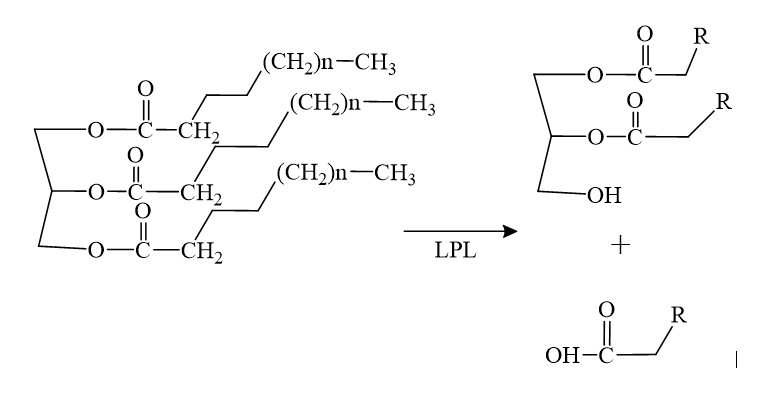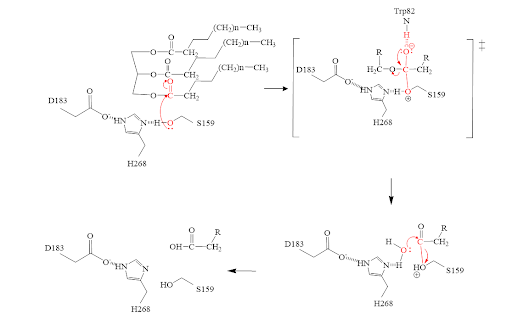User:Hannah Wright/Sandbox 1
From Proteopedia
(Difference between revisions)
| Line 11: | Line 11: | ||
LPL is located within the interstitial space independently and remains stranded there if not acted upon by GPIHBP1. GPIHBP1 then captures LPL in the interstitial spaces and shuttles it across endothelial cells into the capillary lumen. Once in the capillaries, the LPL-GPIHBP1 complex catalyzes the breakdown of triglycerides in the blood. In doing so, it prevents high levels of triglycerides in the plasma to provide nutrients for vital tissues. | LPL is located within the interstitial space independently and remains stranded there if not acted upon by GPIHBP1. GPIHBP1 then captures LPL in the interstitial spaces and shuttles it across endothelial cells into the capillary lumen. Once in the capillaries, the LPL-GPIHBP1 complex catalyzes the breakdown of triglycerides in the blood. In doing so, it prevents high levels of triglycerides in the plasma to provide nutrients for vital tissues. | ||
===Significance=== | ===Significance=== | ||
| - | + | Lipoprotein lipase deficiency leads to hypertriglyceridemia (elevated levels of triglycerides in the blood). This can go on to increase insulin resistance and risk of obesity. | |
<scene name='87/877603/Lplwcolors/1'>Birrane et. al.</scene> | <scene name='87/877603/Lplwcolors/1'>Birrane et. al.</scene> | ||
| Line 17: | Line 17: | ||
== Structure == | == Structure == | ||
===Overall Structure=== | ===Overall Structure=== | ||
| - | ===LPL=== | + | Overall, LPL is a monomer but biologically it is paired with another monomer. These are often referred two as <scene name='87/877603/Chain_a_and_chain_b/2'>Chain A and Chain B</scene>. Chain A (shown as slate blue) and Chain B (shown as magenta) are identical besides orientation. Chain A and B are oriented head to tail. LPL is also complexed with GPIHBP1 (shown as cyan) and is essential for LPL to remain stable and avoid denaturation |
| + | ===LPL===LPL has two main domains, the larger N-terminus domain containing the active site and the smaller C-terminus domain. These two domains are connected via a peptide linker hinge. LPL also contains a large basic patch and a single calcium ion. Additionally, LPL consists of two <scene name='87/877603/Glycans/3'>N-linked glycans</scene> which likely contributes to the correct folding of LPL due to the attached oligosaccharides. Five disulfide bonds contribute to the stabilization throughout LPL’s structure. LPL’s lid region is responsible for regulating the entry of lipid substrates into the active site (hence close proximity to the active site and calcium atom). Representative structures on this page portray the lid region in its believed open conformation. The <scene name='87/877603/Lid_region/1'>lid region</scene> controls entry of lipid substrates into the active site cleft. Lastly, the active site in the larger N-terminus domain is lined with hydrophobic residues. | ||
===GPIHBP1=== | ===GPIHBP1=== | ||
| + | GPIHBP1 (glycosylphosphatidylinositol-anchored high-density lipoprotein-binding protein 1) is a three-fingered LU (Ly6/uPAR) domain. GPIHBP1 is stabilized by five disulfide bonds and is also known for its N-terminal intrinsically disordered acidic domain. | ||
===LPL GPIHBP1 complex=== | ===LPL GPIHBP1 complex=== | ||
====N-terminus of LPL==== | ====N-terminus of LPL==== | ||
| + | The N-terminus of LPL is made up of 6 alpha-helices and 10 beta-strands known as the alpha/beta hydrolase domain. Additionally, alpha/beta hydrolase harbors the catalytic triad. | ||
====C-terminus of LPL==== | ====C-terminus of LPL==== | ||
| - | + | The C-terminus of LPL consists of 12 beta sheets and is known as the C-term flattened beta-barrel domain. The beta-sheets are interacting giving a shape that resembles an elongated cylinder or barrel. | |
| + | ====Interaction of LPL and GPIHBP1==== | ||
| + | GPIHBP1’s LU domain interacts with LPL’s C-terminal domain via hydrophobic interactions. This is largely due to the hydrophobic effect and stabilization. The acidic N-terminal domain of sGPIHBP1 (residues 21–61) is disordered and not visible in the structure, which is presumably due to dynamic interaction with the large basic patch on the LPL. | ||
====Calcium Ion Coordination==== | ====Calcium Ion Coordination==== | ||
| + | he calcium ion has been shown to convert inactive LPL to the active dimer form. The calcium ion is coordinated by residues A194, R197, S199, D201, and D202. Mutations in the side chain of D201, for example, can give rise to detrimental metabolic diseases as LPL can no longer | ||
===Active Site=== | ===Active Site=== | ||
The <scene name='87/878236/Active_site_possibly_done/2'>active site</scene> of LPL is composed of multiple pieces. The <scene name='87/878236/Active_site_hphob_res_w_ligand/1'>hydrophobic tunnel</scene>, including residues: W82, V84, W113, Y121, Y158, L160, A185, P187, F212, I221, F239, V260, V264 and K 265, outline the general structure of the active site and provides considerable stability of the active site. The <scene name='87/878236/Active_site_lid_region_done/1'>lid region</scene> is also an important component of the active site, spanding from residues 243-266, that is vital for the recognition of substrates. The <scene name='87/877636/Activesite_oxyanionhole/2'>oxyanion hole</scene>, which is a small portion of the hydrophobic tunnel consisting of residues L160, and W82, aids in the overall stability of the active site and the transition state of substrates catalyzed by the <scene name='87/877603/Catalytic_triad/1'>catalytic triad</scene> (residues H268, S159, and D183). | The <scene name='87/878236/Active_site_possibly_done/2'>active site</scene> of LPL is composed of multiple pieces. The <scene name='87/878236/Active_site_hphob_res_w_ligand/1'>hydrophobic tunnel</scene>, including residues: W82, V84, W113, Y121, Y158, L160, A185, P187, F212, I221, F239, V260, V264 and K 265, outline the general structure of the active site and provides considerable stability of the active site. The <scene name='87/878236/Active_site_lid_region_done/1'>lid region</scene> is also an important component of the active site, spanding from residues 243-266, that is vital for the recognition of substrates. The <scene name='87/877636/Activesite_oxyanionhole/2'>oxyanion hole</scene>, which is a small portion of the hydrophobic tunnel consisting of residues L160, and W82, aids in the overall stability of the active site and the transition state of substrates catalyzed by the <scene name='87/877603/Catalytic_triad/1'>catalytic triad</scene> (residues H268, S159, and D183). | ||
| Line 29: | Line 35: | ||
====Mechanism==== | ====Mechanism==== | ||
[[Image:MechFinalAllison.png|700 px|]] | [[Image:MechFinalAllison.png|700 px|]] | ||
| - | + | The triglyceride binds to LPL’s lipid-binding region in an open lid conformation. | |
| + | The oxygen on S159 is made more nucleophilic. This happens via histidine hydrogen bonding with the hydrogen on S159’s alcohol group. | ||
| + | The nucleophilic oxygen attacks the carbonyl carbon of one of the fatty acid chains. | ||
| + | This pushes electrons up onto the carbonyl oxygen, creating a tetrahedral intermediate. This is the oxyanion hole which is stabilized by main chain nitrogen atoms of W82 and L160. | ||
| + | One of the lone pairs of the oxygen (in the oxyanion hole) creates a double bond carbon. | ||
| + | The oxygen-carbon bond between the single fatty acid chain and the diglyceride is cleaved. | ||
| + | H268 hydrogen bonds water, making the oxygen a better nucleophile. Water attacks the carbonyl carbon. | ||
| + | The carboxylic acid is formed and the S159 bond is cleaved and re-protonated via H268. | ||
| + | The active site is now back in its original state. | ||
===Inhibitors=== | ===Inhibitors=== | ||
| - | + | This <scene name='87/878236/Active_site_w_inhibitor_bound/4'>inhibitor</scene>, M3D shown in a peach color, was a vital piece in unraveling the correct structure of LPL. With the inhibitor bound, LPL’s active site and lid region become visible and crystallizable, thus this inhibitor is what allowed the first complete crystal structure of LPL to come into existence. This inhibitor also revealed the correct orientation of H268, a residue involved in the catalytic triad. Originally, the hydrogen bonding did not align with substrates in the original crystal structure; however, when this inhibitor was bound, the H268 was flipped, thus aligning the hydrogen bonds in the correct orientation. | |
== Disease == | == Disease == | ||
Revision as of 18:29, 20 April 2021
Lipoprotein Lipase (LPL) complexed with GPIHBP1
| |||||||||||
References
- ↑ Birrane G, Beigneux AP, Dwyer B, Strack-Logue B, Kristensen KK, Francone OL, Fong LG, Mertens HDT, Pan CQ, Ploug M, Young SG, Meiyappan M. Structure of the lipoprotein lipase-GPIHBP1 complex that mediates plasma triglyceride hydrolysis. Proc Natl Acad Sci U S A. 2018 Dec 17. pii: 1817984116. doi:, 10.1073/pnas.1817984116. PMID:30559189 doi:http://dx.doi.org/10.1073/pnas.1817984116
Student/Contributors
- Ashrey Burely
- Allison Welz
- Hannah Wright


